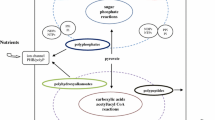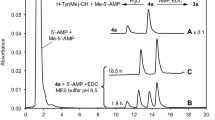Abstract
Polymer formation is arguably one of the essential factors that allowed the emergence, stabilisation and spread of life on Earth. Consequently, studies concerning biopolymers could shed light on the origins of life itself. Of particular interest are RNA and polysaccharide polymers, the archetypes of the contrasting proposed evolutionary scenarios and their respective polymerases. Nucleic acid polymerases were hypothesised, before their discovery, to have a functional similarity with glycogen phosphorylase. Further identification and characterisation of nucleic acid polymerases; particularly of polynucleotide phosphorylase (PNPase), provided experimental evidence for the initial premise. Once discovered, frequent similarities were found between PNPase and glycogen phosphorylase, in terms of catalytic features and biochemical properties. As a result, PNPase was seen as a model of primitive polymerase and used in laboratory precellular systems. Paradoxically, however, these similarities were not sufficient as an argument in favour of an ancestral common polymerisation mechanism prior to polysaccharides and polyribonucleotides. Here we present an overview of the common features shared by polymer phosphorylases, with new proposals for the emergence of polysaccharide and RNA polymers.


Similar content being viewed by others
References
al-Giery AG, Brewer JM (1992) Characterisation of the interaction of yeast enolase with polynucleotides. Biochim Biophys Acta 1159:134–140
Anantharaman V, Koonin EV, Aravind L (2002) Comparative genomics and evolution of proteins involved in RNA metabolism. Nucleic Acids Res 30:1427–1464
Aon MA, Curtino J (1984) Evidence for the glycoprotein nature of retina glycogen. Eur J Biochem 140:557–566
Bailey JM, French D (1957) The significance of multiple reactions in enzyme-polymer systems. J Biol Chem 226:1–14
Baranowski T, Illingworth B, Brown DH, Cori CF (1957) The isolation of pyridoxal-5-phosphate from crystalline muscle phosphorylase. Biochim Biophys Acta 25:16–21
Beljanski M (1996) De Novo Synthesis of DNA-Like Molecules by PolynucleotidePhosphorylase in vitro. J Mol Evol 42:493–499
Blum E, Py B, Carpousis AJ, Higgins CF (1997) Polyphosphate kinase is a component of the Escherichia coli RNA degradosome. Mol Microbiol 26:387–398
Brown MR, Kornberg A (2004) Inorganic polyphosphate in the origin and survival of species. Proc Natl Acad Sci USA 101:16085–16087
Buschiazzo A, Ugalde JE, Guerin ME, Shepard W, Ugalde RA, Alzari PM (2004) Crystal structure of glycogen synthase: homologous enzymes catalyse glycogen synthesis and degradation. EMBO J 23:3196–3205
Bycroft M, Hubbard TJ, Proctor M, Freund SM, Murzin AG (1997) The solution structure of the S1 RNA binding domain: a member of an ancient nucleic acid-binding fold. Cell 88:235–242
Chao J, Johnson GF, Graves DJ (1969) Kinetic mechanism of maltodextrin phosphorylase. Biochemistry 8:1459–1466
Chou JY, Singer MF, McPhie P (1975) Kinetic studies on the phosphorololysis of polynucleotides by polynucleotide phosphorylase. J Biol Chem 250:508–514
Cohn M (1961) Phosphorylases (Survey). In: Boyer PD, Lardy H, Myrback K (eds) The enzymes, vol V. Academic Press, New York
Copley SD, Smith E, Morowitz HJ (2007) The origin of the RNA world: co-evolution of genes and metabolism. Bioorg Chem 35:430–443
Cori GT, Cori CF (1939) The activating effect of glycogen on the enzymatic synthesis of glycogen from glucose-1-phosphate. J Biol Chem 131:397–398
Danchin A (2009) A phylogenetic view of bacterial ribonucleases. Progr Mol Biol Transl Sci 85:1–41
de Duve C (1995) The beginnings of life on Earth. Am Sci 83:428–437
Delaye L, Becerra A, Lazcano A (2005) The last common ancestor: what’s in a name? Orig Life Evol Biosph 35:537–554
Gibbons BJ, Roach PJ, Hurley T (2002) Crystal structure of the autocatalytic initiator of glycogen biosynthesis, glycogenin. J Mol Biol 319:463–477
Godefroy-Colburn T, Grunberg-Manago M (1972) Polynucleotide phosphorylase. In: Boyer PD, Lardy H, Myrback K (eds) The Enzymes, vol VII. Academic Press, New York
Graves DJ, Wang JH (1972) α-Glucan phosphorylases-chemical and physical basis of catalysis and regulation. In: Boyer PD (ed) The enzymes, vol VII. Academic Press, New York
Grunberg-Manago M, Ochoa S (1955) Enzymatic synthesis and breakdown of polynucleotides: polynucleotide phosphorylase. JACS 77:3165–3166
Grunberg-Manago M, Ortiz PJ, Ochoa S (1956) Enzymic synthesis of polynucleotides. I. Polynucleotide phosphorylase of Azotobacter vinelandii. Biochim Biophys Acta 20:269–285
Jadhav VR, Yarus M (2002) Coenzymes as coribozymes. Biochimie 84:877–888
Joyce GF (2002) The antiquity of RNA-based evolution. Nature 418:214–221
Kainuma K, French D (1972) Nageli amylodextrin and its relationship to starch granule structure. II. Role of water in crystallization of B-starch. Biopolymers 11:2241–2250
Kim ΚΜ, Caetano-Anollés G (2010) Emergence and evolution of modern molecular functions inferred from phylogenomic analysis and ontological data. Mol Biol Evol 27:1710–1733
Kitamura T, Peyrard M, Cuesta Lopez S (2005) A model on the origin of RNA. Phys Biol 2:200–206
Kornberg A (2001) Remembering our teachers. J Biol Chem 276:3–11
Kornberg A, Lehman IR, Bessman MJ, Simms ES (1956) Enzymic synthesis of deoxyribonucleic acid. Biochim Biophys Acta 21:197–198
Kuhnel K, Luisi BF (2001) Crystal structure of the Escherichia coli RNA degradosome component enolase. J Mol Biol 313:583–592
Lazcano A, Llaca V, Capello R, Valverde V, Oro J (1992) The origin and early evolution of nucleic acid polymerases. Adv Space Res 12:207–216
Leloir LF (1983) Far away and long ago. Annu Rev Biochem 52:1–15
Lomako J, Lomako WM, Whelan WJ, Marchase RB (1993) Glycogen contains phosphodiester groups that can be introduced by UDPglucose: glycogen glucose 1-phosphotransferase. FEBS Lett 329:263–267
Lomako J, Lomako WM, Whelan WJ (2004) Glycogenin: the primer for mammalian and yeast glycogen synthesis. Biochim Biophys Acta 1673:45–55
Mamaeva OK, Karpeiskii MI, Karpeiskii AM, Bibilashvili RSh (1979) Interaction of oligophosphates of pyridoxal with certain enzymes of polynucleotide synthesis. Mol Biol (Mosk) 13:811–821
Martin G, Keller W (2007) RNA-specific ribonucleotidyl transferases. RNA 13:1834–1849
Metzler DE (2001) Biochemistry: the chemical reactions of living cells, 2nd edn. Academic Press, New York
Mii S, Ochoa S (1957) Polyribonucleotide synthesis with highly purified polynucleotide phosphorylase. Biochim Biophys Acta 26:445–446
Monhanty BK, Kuhsner KS (2000) Polynucleotide phosphorylase functions both as 3′ right-arrow 5′ exonuclease and a polymerase (A) in Escherichia coli. Proc Natl Acad Sci USA 97:11966–11971
Murzin AG (1993) OB (oligonucleotide/oligosaccharide binding)-fold: common structural and functional solution for non-homologous sequences. EMBO J 12:861–867
Nagai K, Oubridge C, Jessen TH, Li J, Evans PR (1990) Crystal structure of the RNA-binding domain of the U1 small nuclear ribonucleoprotein A. Nature 348:515–520
Oberholzer T, Luisi PL (2002) The use of liposomes for constructing cell models. J Biol Phys 28:733–744
Oparin AI, Evreinova TN, Larionova TI, Davydova IM (1962) Synthesis and degradation of starch in coacervates droplets. Dokl Akad Nauk SSSR 143:980–983
Oparin AI, Serebroskaya KB, Pantskva SN, Vasileva NV (1963) Enzymatic synthesis of polyadenylic acid in coacervates drops. Biokhimiia 28:671–675
Orgel LE (2004) Prebiotic chemistry and the origin of the RNA world. Crit Rev Biochem Mol Biol 39:99–123
Palm D, Klein HW, Schinzel R, Buehner M, Helmreich EG (1990) The role of pyridoxal 5′-phosphate in glycogen phosphorylase catalysis. Biochem 29:1099–1107
Rauhut R, Klug G (1999) mRNA degradation in bacteria. FEMS Microbiol Rev 23:353–370
Saladino R, Crestini C, Ciambecchini U, Ciciriello F, Costanzo G, Di Mauro E (2004) Synthesis and degradation of nucleobases and nucleic acids by formamide in the presence of montmorillonites. Chembiochem 5:1558–1566
Sanchez RA, Orgel LE (1970) Studies in prebiotic synthesis.V. Synthesis and photoanomerization of pyrimidine nucleosides. J Mol Biol 47:531–543
Schwartz AW, Orgel LE (1985) Template-directed synthesis of novel, nucleic acid-like structures. Science 228:585–587
Stadtman ER (1973) Adenylyl transfer reactions. In: Boyer PD (ed) The enzymes, vol VIII. Academic Press, New York
Steitz TA (1998) A mechanism for all polymerases. Nature 391:231–232
Stern R, Jedrzejas MJ (2008) Carbohydrates polymers at the center of life’s origin: the importance of molecular processivity. Chem Rev 108:5061–5085
Sun W, Pertzev A, Nicholson AW (2005) Catalytic mechanism of Escherichia coli ribonuclease III: kinetic and inhibitor evidence for the involvement of two magnesium ions in RNA phosphodiester hydrolysis. Nucleic Acids Res 33:807–815
Symmons MF, Jones GH, Luisi BF (2000) A duplicated fold is the structural basis for polynucleotide phosphorylase catalytic activity, processivity, and regulation. Structure 8:1215–1226
Tolstoguzov V (2004) Why were polysaccharides necessary? Orig Life Evol Biosph 34:571–597
Ugalde JE, Parodi AJ, Ugalde RA (2003) De novo synthesis of bacterial glycogen: Agrobacterium tumefaciens glycogen synthase is involved in glucan initiation and elongation. Proc Natl Acad Sci USA 100:10659–10663
Watson JD, Crick FHC (1953a) Molecular structure of nucleic acids. Nature 171:737–738
Watson JD, Crick FHC (1953b) Genetical implications of the structure of deoxyribonucleic acid. Nature 171:964–967
Weber AL (2005) Growth of organic microspherules in sugar-ammonia reactions. Orig Life Evol Biosph 35:523–536
Yehudai-Resheff S, Hirsh M, Schuster G (2001) Polynucleotide phosphorylase functions as both an exonuclease and a poly(A) polymerase in spinach chloroplasts. Mol Cell Biol 21:5408–5416
Zuo Y, Deutscher MP (2001) Exoribonuclease superfamilies: structural analysis and phylogenetic distribution. Nucleic Acids Res 29:1017–1026
Acknowledgments
I wish to thank Ms. E. Vega for editing the manuscript, Dr. S. Burgess for revision and correction of the text, and CONICET for financial support.
Author information
Authors and Affiliations
Corresponding author
Rights and permissions
About this article
Cite this article
Freire, M.A. Polymer phosphorylases: clues to the emergence of non-replicative and replicative polymers. Theory Biosci. 130, 279–287 (2011). https://doi.org/10.1007/s12064-011-0131-2
Received:
Accepted:
Published:
Issue Date:
DOI: https://doi.org/10.1007/s12064-011-0131-2




